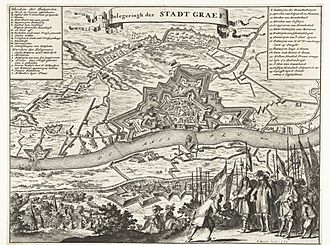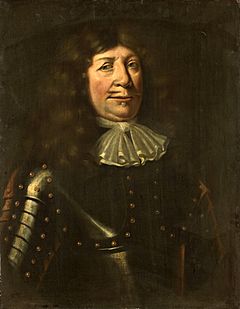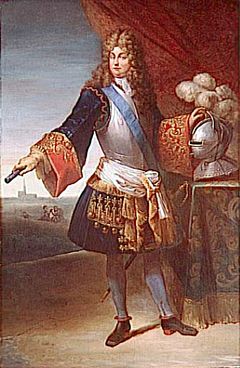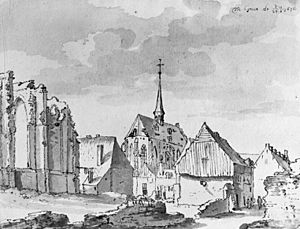Siege of Grave (1674) facts for kids
Quick facts for kids Siege of Grave (1674) |
|||||||
|---|---|---|---|---|---|---|---|
| Part of the Franco-Dutch War | |||||||
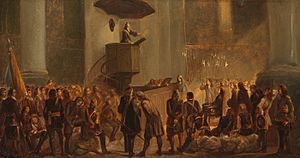 The thanksgiving service of William III's army in Grave after its capture |
|||||||
|
|||||||
| Belligerents | |||||||
| Commanders and leaders | |||||||
| Strength | |||||||
| 4,000 men 450 guns of which 100 were in use |
30,000 men (10,000 reinforcements arrived on 9 October) | ||||||
| Casualties and losses | |||||||
| 2,000 | 7,000-8,000 | ||||||
The Siege of Grave was a big battle that happened from July 25 to October 27, 1674. It was part of the Franco-Dutch War (1672-1678). During this siege, a Dutch army took back the fortress town of Grave in what is now the Netherlands. The French army had taken Grave in the summer of 1672.
Why the Siege Happened
In May 1672, France, with help from Münster and Cologne, attacked the Dutch Republic. They almost took over the whole country. Grave, a very strong town on the Meuse river, was captured by the French on July 5, 1672. However, the French advance into Holland, the most important Dutch province, was stopped by the Dutch Water Line. This was a defense system using flooded land.
Later, in 1673, other countries like the Holy Roman Empire, Spain, and Lorraine joined the war to help the Dutch. France had to move many of its soldiers to other battlefronts. This gave the Dutch a chance to fight back. They captured Naarden in September and Bonn in November. These losses made the French king, Louis XIV, pull his troops out of most of the Dutch Republic. By 1674, the French only held two places in the Netherlands: Maastricht and Grave.
The Battle for Grave
The town of Grave was cut off from other French areas. The French defenders, led by Noël Bouton de Chamilly, turned the town into a "hedgehog fortress." This meant it was very strong and hard to attack from any side.
A Dutch army, with some Spanish and Brandenburgian soldiers, was sent to capture Grave. This army was led by Lieutenant-General Carl von Rabenhaupt. But there were problems with paying the soldiers and getting supplies. So, it took a long time for the siege to start. The army finally began the attack on July 25. During this delay, Chamilly made the fortress even stronger.
The French defenses were very good, which made the siege difficult for the attackers. French cannons fired effectively, making it hard for the Dutch to dig trenches close to the walls. The Meuse river also made it harder to attack. On August 11, the Dutch finished building a defensive line around the town. This line helped protect them from any French army that might try to help Grave. The Dutch also changed the flow of the Raam river. This filled their own moats with water, while taking water away from Grave's moats.
Later, Menno van Coehoorn, a famous expert in building fortresses, came to give advice to Rabenhaupt. However, Rabenhaupt, who was 71 years old, did not follow his advice.
The Dutch, Spanish, and the Holy Roman Emperor had big plans for 1674. They wanted to use over 120,000 soldiers in three different war zones. The biggest effort was planned for the Spanish Netherlands. There, over 70,000 soldiers were ready, led by William of Orange. They thought they would easily outnumber the French.
However, the French army in the Spanish Netherlands, led by Condé, was stronger than expected. This, along with poor teamwork among the Allied leaders, meant their campaign did not go well. At the Battle of Seneffe, both sides fought a very bloody battle, but neither side truly won. William of Orange was frustrated. He decided to join Rabenhaupt's army at Grave with 10,000 extra troops.
De Chamilly felt honored that the famous William of Orange had come to fight him. He wanted to prove himself worthy. William, helped by his cousin Henry Casimir II, brought many cavalry and foot soldiers. This added about 10,000 troops to the siege. William set up his headquarters and took charge of the siege. But even with William leading, the fortress kept holding out. It seemed like weapons alone could not end the siege.
King Louis XIV of France had originally wanted to take over the Dutch Republic. Since that plan had failed, holding onto an isolated place like Grave did not make much sense. So, the French king told his commander to give up the siege. After a short break for talks, de Chamilly surrendered on October 27. He was given very good terms and was allowed to leave with "honors of war." This meant his soldiers could march out with their weapons and flags, showing they had fought bravely. William of Orange respected de Chamilly for his strong defense.
What Happened Next
The French soldiers left Grave the next day. On the same day, William of Orange and many soldiers from the Dutch States Army went to a church in Grave. The church was badly damaged from the fighting. William attended a thanksgiving service there.
Grave was almost completely destroyed. We don't know how many people living in the town died, but they suffered greatly. More than 100,000 cannonballs and 3,000 bombs hit the town and its defenses. This caused a lot of death and destruction in the small fortress.
Capturing Grave was a small victory compared to the big plans the Allies had at the start of the year. Still, it was important because all the lands next to the Dutch Republic were now back in Dutch hands. Only Maastricht was still held by the French.
The Siege of Grave and the Battle of Seneffe showed how the war had changed. Two years after France's quick attack, the war had become a long, tiring fight. Armies were bigger, and battles were happening in more places, leading to more casualties. The Allies and France were about equally strong. But neither side was tired enough of the war to agree to peace yet.
Sources


